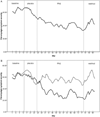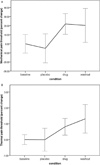Fibromyalgia symptoms are reduced by low-dose naltrexone: a pilot study
- PMID: 19453963
- PMCID: PMC2891387
- DOI: 10.1111/j.1526-4637.2009.00613.x
Fibromyalgia symptoms are reduced by low-dose naltrexone: a pilot study
Abstract
Objective: Fibromyalgia is a chronic pain disorder that is characterized by diffuse musculoskeletal pain and sensitivity to mechanical stimulation. In this pilot clinical trial, we tested the effectiveness of low-dose naltrexone in treating the symptoms of fibromyalgia.
Design: Participants completed a single-blind, crossover trial with the following time line: baseline (2 weeks), placebo (2 weeks), drug (8 weeks), and washout (2 weeks).
Patients: Ten women meeting criteria for fibromyalgia and not taking an opioid medication.
Interventions: Naltrexone, in addition to antagonizing opioid receptors on neurons, also inhibits microglia activity in the central nervous system. At low doses (4.5 mg), naltrexone may inhibit the activity of microglia and reverse central and peripheral inflammation.
Outcome measures: Participants completed reports of symptom severity everyday, using a handheld computer. In addition, participants visited the lab every 2 weeks for tests of mechanical, heat, and cold pain sensitivity.
Results: Low-dose naltrexone reduced fibromyalgia symptoms in the entire cohort, with a greater than 30% reduction of symptoms over placebo. In addition, laboratory visits showed that mechanical and heat pain thresholds were improved by the drug. Side effects (including insomnia and vivid dreams) were rare, and described as minor and transient. Baseline erythrocyte sedimentation rate predicted over 80% of the variance in drug response. Individuals with higher sedimentation rates (indicating general inflammatory processes) had the greatest reduction of symptoms in response to low-dose naltrexone.
Conclusions: We conclude that low-dose naltrexone may be an effective, highly tolerable, and inexpensive treatment for fibromyalgia.
Figures



Similar articles
-
Low-dose naltrexone for the treatment of fibromyalgia: findings of a small, randomized, double-blind, placebo-controlled, counterbalanced, crossover trial assessing daily pain levels.Arthritis Rheum. 2013 Feb;65(2):529-38. doi: 10.1002/art.37734. Arthritis Rheum. 2013. PMID: 23359310 Clinical Trial.
-
The Safety and Efficacy of Low-Dose Naltrexone in the Management of Chronic Pain and Inflammation in Multiple Sclerosis, Fibromyalgia, Crohn's Disease, and Other Chronic Pain Disorders.Pharmacotherapy. 2018 Mar;38(3):382-389. doi: 10.1002/phar.2086. Epub 2018 Feb 23. Pharmacotherapy. 2018. PMID: 29377216 Review.
-
Effects of naltrexone on pain sensitivity and mood in fibromyalgia: no evidence for endogenous opioid pathophysiology.PLoS One. 2009;4(4):e5180. doi: 10.1371/journal.pone.0005180. Epub 2009 Apr 13. PLoS One. 2009. PMID: 19365548 Free PMC article. Clinical Trial.
-
Clinical utility of the cold pressor test: evaluation of pain patients, treatment of opioid-induced hyperalgesia and fibromyalgia with low dose naltrexone.Discov Med. 2018 Nov;26(144):197-206. Discov Med. 2018. PMID: 30695679
-
[Low dose naltrexone for treatment of pain].Ugeskr Laeger. 2015 Oct 9;177(43):V03150248. Ugeskr Laeger. 2015. PMID: 26509454 Review. Danish.
Cited by
-
Corneal neuropathic pain: a review to inform clinical practice.Eye (Lond). 2024 Aug;38(12):2350-2358. doi: 10.1038/s41433-024-03060-x. Epub 2024 Apr 16. Eye (Lond). 2024. PMID: 38627548 Free PMC article. Review.
-
Low-Dose Naltrexone as an Adjuvant in Combined Anticancer Therapy.Cancers (Basel). 2024 Mar 21;16(6):1240. doi: 10.3390/cancers16061240. Cancers (Basel). 2024. PMID: 38539570 Free PMC article. Review.
-
Microglial STING activation alleviates nerve injury-induced neuropathic pain in male but not female mice.Brain Behav Immun. 2024 Mar;117:51-65. doi: 10.1016/j.bbi.2024.01.003. Epub 2024 Jan 6. Brain Behav Immun. 2024. PMID: 38190983 Free PMC article.
-
Assessing Ethnic Minority Representation in Fibromyalgia Clinical Trials: A Systematic Review of Recruitment Demographics.Int J Environ Res Public Health. 2023 Dec 15;20(24):7185. doi: 10.3390/ijerph20247185. Int J Environ Res Public Health. 2023. PMID: 38131736 Free PMC article. Review.
-
Altered response to Toll-like receptor 4 activation in fibromyalgia: A low-dose, human experimental endotoxemia pilot study.Brain Behav Immun Health. 2023 Nov 17;34:100707. doi: 10.1016/j.bbih.2023.100707. eCollection 2023 Dec. Brain Behav Immun Health. 2023. PMID: 38020479 Free PMC article.
References
-
- Nuemann L, Buskila D. Epidemiology of fibromyalgia. Curr Pain Headache Rep. 2003;7:362–368. - PubMed
-
- White KP, Speechley M, Harth M, et al. The London fibromyalgia study: The prevalence of fibromyalgia syndrome in London, Ontario. J Rheumatol. 1999;26:1570–1576. - PubMed
-
- Yunus MB. Towards a model of pathophysiology of fibromyalgia: Aberrant central pain mechanisms with peripheral modulation. J Rheumatol. 1992;19:846–850. - PubMed
-
- Waylonis GW, Heck W. Fibromyalgia syndrome. New associations. Am J Phys Med Rehabil. 1992;71:343–348. - PubMed
-
- Kaplan KH, Goldenberg DL, Galvin-Nadeau M. The impact of a meditation-based stress reduction program on fibromyalgia. Gen Hosp Psychiatry. 1993;15:284–289. - PubMed
Publication types
MeSH terms
Substances
Grants and funding
LinkOut - more resources
Full Text Sources
Other Literature Sources
Medical
Miscellaneous


